How To Clean Houseplant Leaves: How & Why To Do It
Clean houseplants are happy houseplants. I keep my indoor plants clean because they breathe better and look a whole lot better, too. Learning how to clean houseplant leaves is simple and can be done naturally, whether you’ve got large leafy ones or smaller, delicate varieties. It’s also a great way to check in on your plant’s overall health.
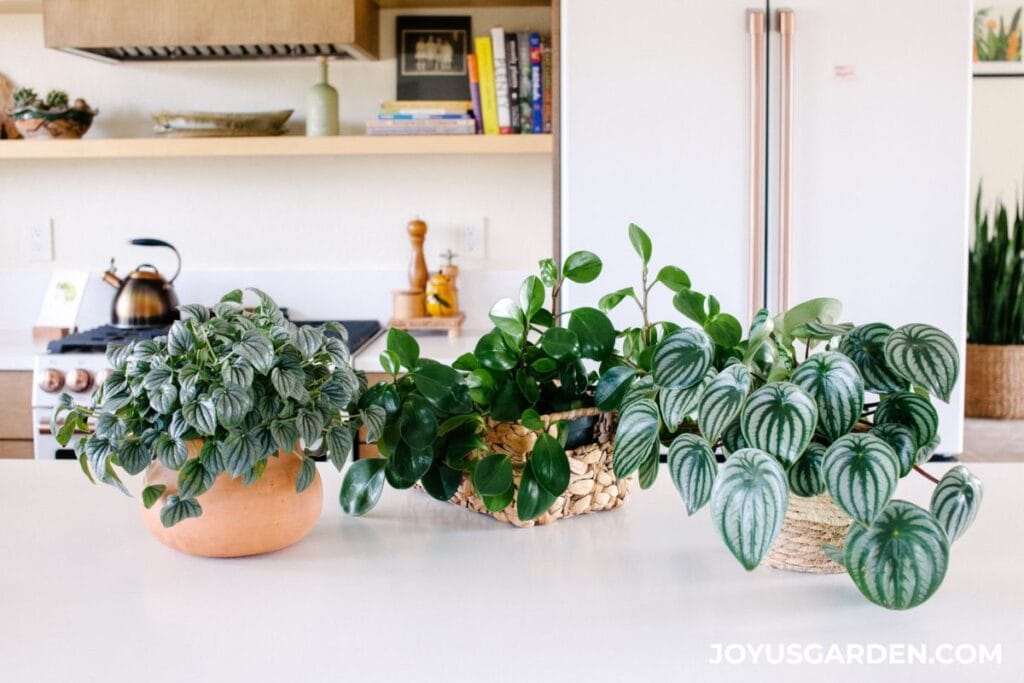
A Guide On How To Clean Houseplant Leaves
Reasons for Cleaning Houseplants
1) They often arrive from the growers’ greenhouses to the store or nursery, and eventually to you, with a layer of grime or ‘crud’ on their leaves. This is commonly due to pesticide spraying, foliage cleaners, condensation dripping from the ceiling, misting, and most notably, hard water.
Hard water is high in minerals, and just like it can leave spots on your glassware, it can leave white residue on your plant’s leaves.
Hard water is high in minerals. Just like it can cause spots on your glassware, it can cause white spots on the leaves of your plants to appear.
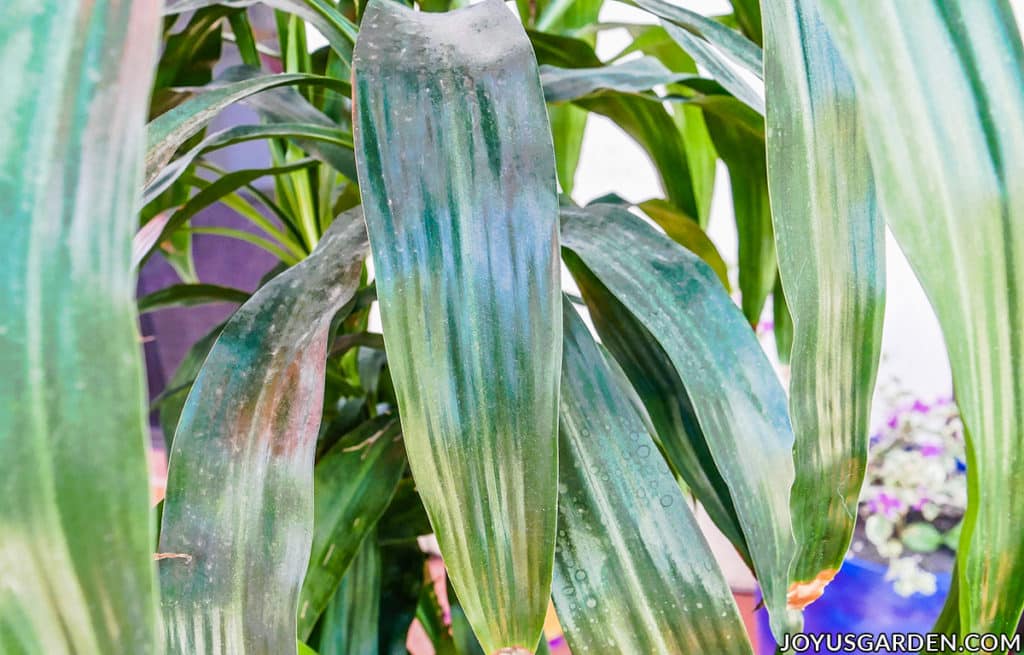

2) You need to get the buildup of dust and dirt off that has built up in your home so your plants can breathe better. The leaves of houseplants need to respire, and a heavy build-up of dust can impede the plant’s ability to do so, as well as block light absorption.
3) If your indoor plants have ever had pest infestations, you may need to remove any residue left behind. Sucking insects like mealybugs, scale, aphids, and whiteflies secrete a sticky substance that can stain the leaves. You’ll want to wipe that off, along with any eggs that might remain. Be sure to discard the cloth you used in case any eggs have survived. Pests can spread like crazy to other houseplants in no time.
4) Clean plants are healthy plants. In addition to all the reasons above, cleaning provides an opportunity to take a closer look at your plant. You might spot pests, damage, or other issues early, before they turn into bigger problems.
5) This is my favorite reason for cleaning plant leaves: Plants look better when clean!
Mixture for Cleaning Houseplants

This is what I’ve used for years to clean indoor plants. I no longer measure the few ingredients out because I know the approximate portions.
- 1/4 – 1/2 cup white vinegar (be careful – too much can burn the leaves of your houseplants)
- 1/2 gallon lukewarm water (around 8 cups)
- 5-10 drops of non-toxic liquid soap
- Spray bottle, a soft cleaning cloth, and a pail or large bowl
You can see what works best for you—a simple solution of a few drops of castile soap in a few cups of water often does the trick. If there’s little buildup, I use plain water and a soft cloth to wipe the leaves gently.
How to Clean Houseplants
I clean different plants in various ways, depending on their size, leaf shape, and surface texture. As your collection grows (it’s addicting, trust me!), you’ll figure out what works best for each type of plant. To help you get started, here are some simple methods I use to clean my plants safely and naturally.
1) When there is a light dust build-up, I use a duster. I’ve had mine for years, but a microfiber one would work just fine because it can be easily washed. A soft cloth dampened with water also does the trick.
2) I take my smaller houseplants to my deep kitchen sink and spray them. Not too hard – you don’t want to blast any of the soil mix out of the pot. I do this every few months to remove surface dust. I let them sit in the sink for an hour or so because I live in the desert and I think it temporarily ups the humidity factor (who knows, but it must make the plants feel good!)
When it rains and the wind isn’t whipping, I’ll put them outside for a good ole shower sent straight from Mother Nature.

3) I spray the mixture on the plant with a spray bottle and let it drip off, hopefully taking off some of the dust and spots. I use this method on plants with a lot of smaller leaves, like Ficus benjaminas or Pothos with long trailing stems. I do this outdoors (out of the hot sun) if possible, but when doing it indoors, I make sure to protect my floors, furniture, etc.
4) I use a soft, damp cloth soaked in the mixture listed above and wipe off the leaves. I use this method for houseplants with larger leaves such as Dracaena Lisa, Dracaena massangeana, Phildendrons, Monsteras, etc.
5) For smaller plants with larger leaves, I often spray the mixture on and wipe it off with a dampened cloth. For extra measure, I’ll take them to the kitchen and give them a follow-up spray with water in the sink.
By the way, I always let the leaves dry naturally, regardless of the method I’m using.
Don’ts When it Comes to Cleaning Houseplants
1) Don’t put your plants in the hot sun to dry after you clean them. They could burn.
2) Don’t use commercial cleaners. Those leaf shining products contain additives that clog the pores of the leaves, which need to respire. Plus, too much shine can make those naturally shiny leaves look fake!
I’ve heard of people using coconut oil, olive oil, mayonnaise, and/or milk to clean and shine their indoor plants. I have no experience with this. Do some research of your own on this subject. I do know that oil can build up on the leaves, clogging the pores and attracting dust.
3) Don’t use my spray mixture listed above on plants with hairy leaves. Most that I know of, like African Violets and Gloxinias, don’t like to be sprayed with cleaners. Dusting is best.
For plants with delicate leaves, I use a soft, damp cloth and a spray bottle filled with room-temperature water.
4) This is something I believe and wanted to pass along for you to consider: try not to clean your houseplants too late at night. After dark, plants shift into their nighttime respiration mode—a key part of how they breathe and function. I like to give them that time to rest undisturbed. Plus, it’s easier to see what you’re doing in the daylight hours!
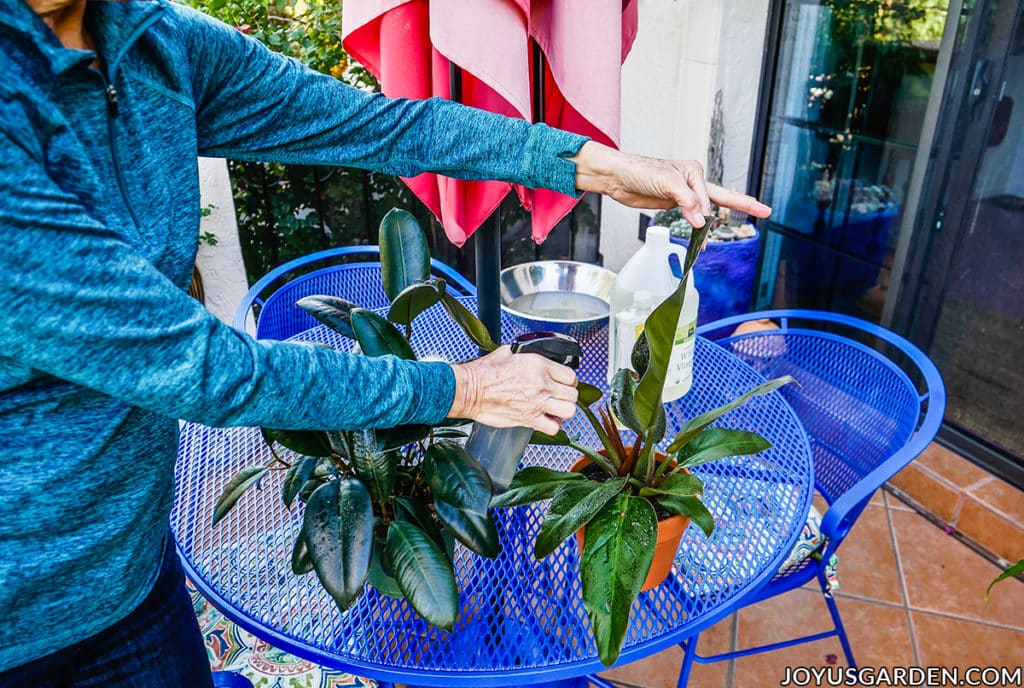

How Often Should You Clean Houseplants?
There’s no strict schedule to follow—clean your houseplants whenever they start looking dusty or dull. I don’t stick to a routine myself. I usually get to it in the summer when it’s blazing hot here in the Sonoran Desert, and I’m indoors more during the day.
For you, winter might be the right time. The good news? Your plants don’t care when it happens—they’re just happy to be clean and free of dust, dirt, and spots.
If we get some rare summer rain (without wind), I’ll take the opportunity to let my small to medium-sized plants soak it up outside. There’s nothing like a gentle rain to give them a refreshing cleanse straight from nature.
How To Clean Houseplant Leaves FAQs
Is it okay to use baby wipes or wet wipes to clean the leaves of my houseplants?
No, they most likely contain additives that can harm your plant’s leaves over time. It’s best to stick with a microfiber or other soft, chemical-free cloth, dampened with plain water or a mild soap solution (such as castile) diluted in water.
Can I use mayonnaise or oil to polish the leaves?
No, although the leaves will temporarily be nice and shiny, looking like disco balls, mayo or oil will clog the pores of the leaves, hindering the breathing process and attracting dust.
What’s the best way to dry the leaves after cleaning?
It’s simple – just let them air dry!
What’s the safest and easiest way to clean succulents or cacti?
I live in the Arizona desert and grow a variety of succulents and cacti indoors. To clean them, I use paintbrushes of various sizes with medium to soft bristles—they’re great for getting into tight spots without damaging the plants. I don’t need to do it often—once every year or two is usually enough for mine.
How do I clean tall houseplants I can’t reach?
I have three plants over 7′ tall and use a 6′ ladder to climb up and clean them. Don’t worry if you don’t have a tall ladder—there are telescoping microfiber dusters that make it easy to reach those high-up leaves without the climb.
I was cleaning my plant and noticed it has sticky leaves—what does that mean?
Sticky leaves typically indicate a pest problem, such as mealybugs, aphids, or spider mites. Clean the leaves first and then treat them with neem oil or insecticidal soap. Since pests can spread from plant to plant, toss the cleaning cloth when you’re done.
How can I remove hard water spots from the leaves of my houseplants?
Hard water can leave mineral deposits on foliage, and they’re often tough to remove. Check out the “mixture for cleaning houseplants” section to see what I use.
Sometimes it takes more than one go—don’t worry if the spots don’t come off right away. You may need to repeat the process once or twice to get those leaves clean and lookin’ good.
How to Clean Houseplant Leaves Video Guide (this video was uploaded years ago)
Conclusion: Unless you’re Pig-Pen, I’m guessing you wouldn’t want to be covered in dust all the time—and neither do your plants. Make cleaning leaves a natural part of your plant care routine, and your indoor garden will look fresh as a daisy. A little wipe-down goes a long way toward happy, healthy houseplants!
Happy gardening,


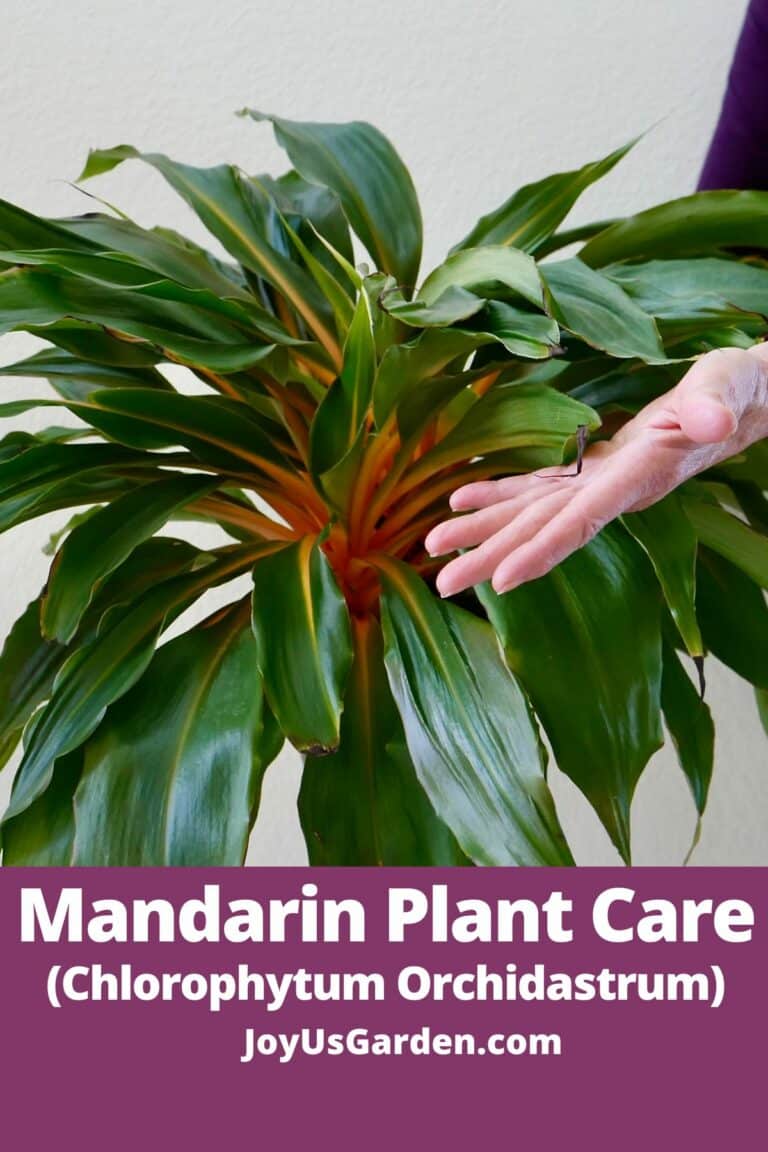

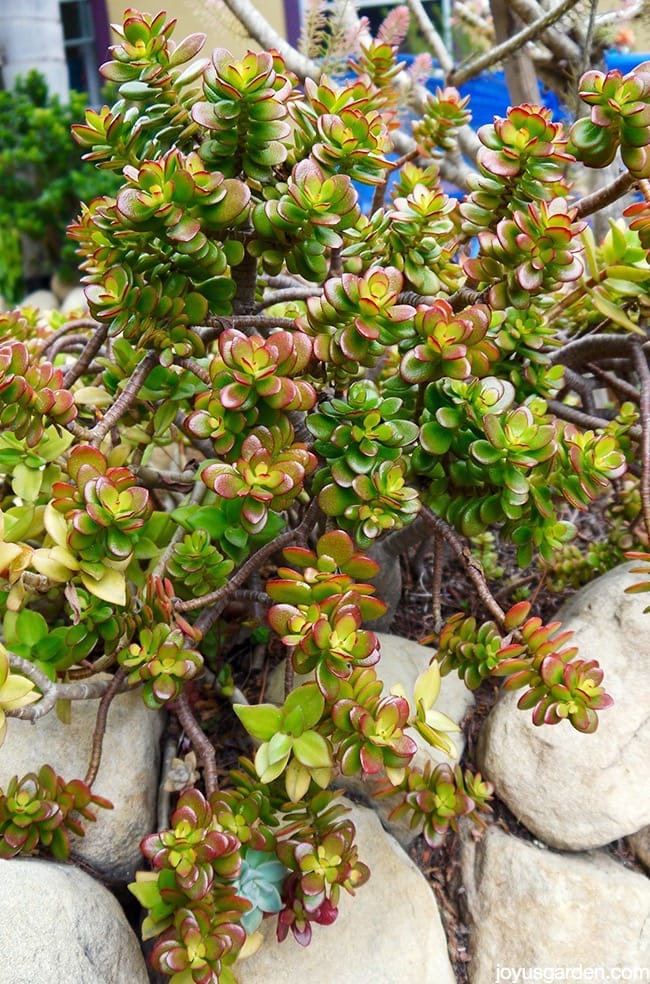
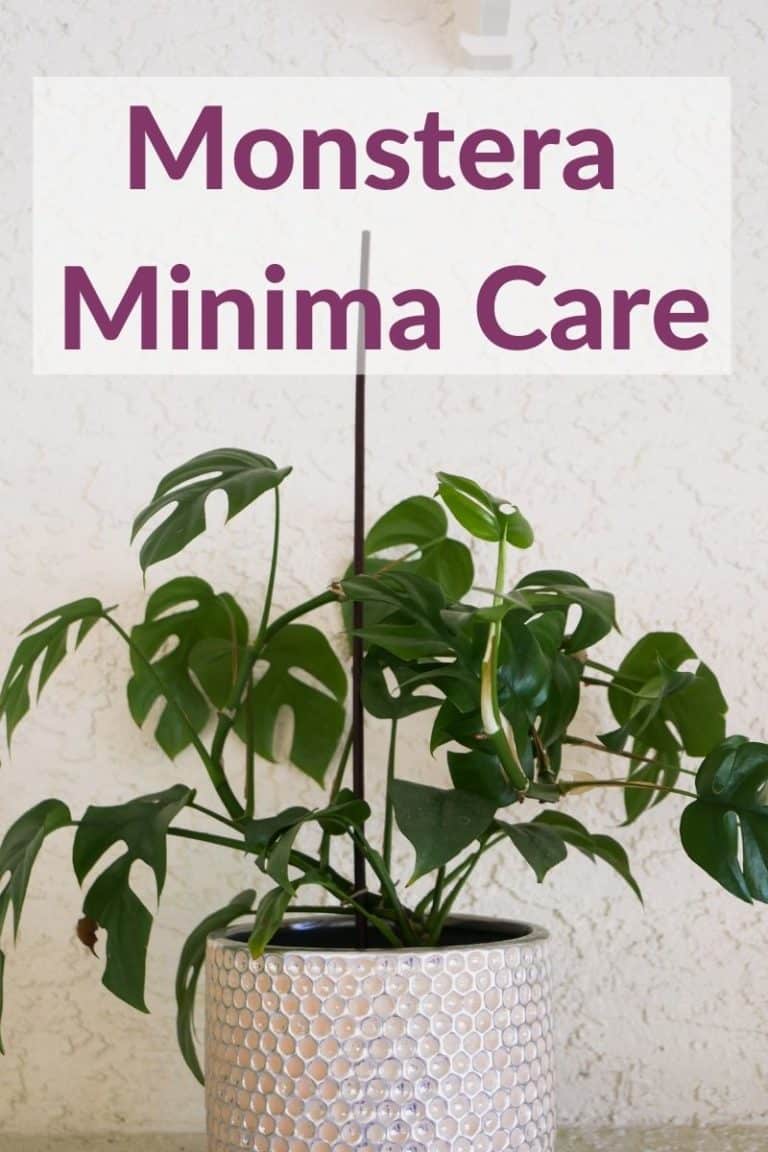
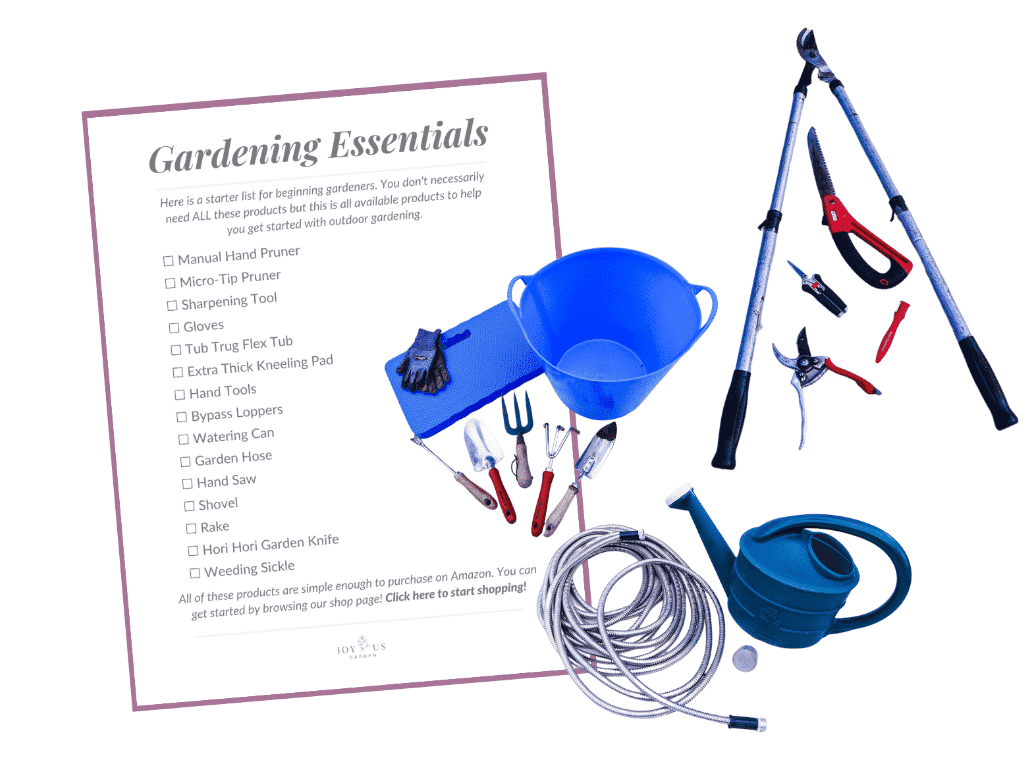
Great tips for cleaning! Thanks for sharing.
My pleasure Marnie! Nell
I heard years ago to shine leaves with the inside of banana peels. Ever heard of this?
Hi Gwen – I know banana peels are used plant food but I’ve never heard of them being used for cleaning. It certainly wouldn’t hurt the plant so it would be worth a try! Nell
I have an 87 yearold friend who says you can use hairspray for the leaves on your houseplants! I told her NO, they have to breathe and hairspray would suffocate them. What say you please?
Oh goodness no, I wouldn’t do that. I agree with you! The leaves need to breathe & hairspray will clog them. I do know that hairspray is sometimes used as a fixative for dried flowers to help the color last. Nell